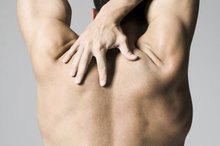Pain at the Back of the Legs Between the Thighs & the Calves
Muscle pain, spasms and cramping in the back of legs can develop for a variety of reasons. Simply straining the muscles can cause discomfort between the thighs and calves. In some cases medical conditions may lead to muscle aches or sharp pain in the back of upper legs and behind the knees.
Considerations
A muscle spasm, commonly referred to as a charley horse, may occur due to injury or overuse. Exercising when your body is deficient in calcium, potassium or other minerals or when dehydrated can make you more prone to muscle spasms and cramping. Fluids allow your muscles to tighten and relax more effortlessly, the Mayo Clinic explains.
Effects
Are There Foods That Are Muscle Relaxants?
Learn More
Muscle cramps typically strike the back of the lower calf, or gastrocnemius, back of the thigh, or hamstrings, and the front of the upper leg, known as the quadriceps. When a muscle is in spasm, it tightens uncontrollably and refuses to relax, the MedlinePlus online medical encyclopedia notes. Muscle spasms are generally harmless.
Conditions
Peripheral artery disease is a common circulatory condition that causes cramp-like pains or contractions in your calf, thigh or hip muscles when the arteries that send blood to your legs become obstructed. Discomfort usually subsides when you rest your legs, the Mayo Clinic reports.
Fibromyalgia can cause intense muscle aches and shooting pain in various areas of the body, including the thighs. Fibromyalgia is typically accompanied by headaches, fatigue and sleep disturbances.
- Peripheral artery disease is a common circulatory condition that causes cramp-like pains or contractions in your calf, thigh or hip muscles when the arteries that send blood to your legs become obstructed.
Treatment
Muscle Fatigue, Twitches & Joint Pain
Learn More
Placing heat on a muscle spasm can help diminish discomfort. Ice packs may provide additional comfort once the initial pain has subsided. Stretching and massaging the affected muscle can also provide relief. Non-steroidal anti-inflammatory medications like aspirin and ibuprofen can also help decrease pain. Your doctor can prescribe anti-spasm medications in severe cases.
Peripheral artery disease can often be treated by making healthy lifestyle changes like quitting smoking and eating a nutritious diet, the Mayo Clinic advises. Medications to help lower blood pressure and cholesterol may also help.
Fibromyalgia patients may benefit from physical as well as behavioral therapy, reports MedlinePlus. Muscle relaxants and antidepressant medications may also help relieve symptoms in some cases.
- Placing heat on a muscle spasm can help diminish discomfort.
- Non-steroidal anti-inflammatory medications like aspirin and ibuprofen can also help decrease pain.
Outlook
Stretching your legs before exercising may help thigh pain. Stretching before bedtime may help prevent leg cramps while you sleep, the Mayo Clinic suggests. Contact your doctor if muscle cramps are severe or persistent.
Related Articles
References
- Mayo Clinic: Peripheral artery disease (PAD)
- MedlinePlus: Baker’s Cyst
- MedlinePlus: Muscle Cramps
- Mayo Clinic: Muscle Cramps
- MedlinePlus: Fibromyalgia
- Cleveland Clinic. Muscle Pain: Possible Causes. Updated December 3, 2017.
- American Academy of Orthopaedic Surgeons. Sprains, Strains and Other Soft-Tissue Injuries. Updated July 2015.
- Allen RE, Kirby KA. Nocturnal leg cramps. Am Fam Physician. 2012;86(4):350-5.
- Jafri MS. Mechanisms of Myofascial Pain. Int Sch Res Notices. 2014;2014:523924. doi:10.1155/2014/523924
- American Academy of Orthopaedic Surgeons. Compartment Syndrome. Updated October 2009.
- Genetic and Rare Diseases Information Center. Pyomyositis.
- Centers for Disease and Prevention. Flu Symptoms & Complications. Updated September 18, 2019.
- Barry AR, Beach JE, Pearson GJ. Prevention and management of statin adverse effects: A practical approach for pharmacists. Can Pharm J (Ott). 2018;151(3):179–188. doi:10.1177/1715163518768534
- Ozaras N, Rezvani A. Diffuse skeletal pain after administration of alendronate. Indian J Pharmacol. 2010;42(4):245–246. doi:10.4103/0253-7613.68435
- Younus J, Kligman L. Management of aromatase inhibitor-induced arthralgia. Curr Oncol. 2010;17(1):87–90. doi:10.3747/co.v17i1.474
- National Institute of Arthritis and Musculoskeletal and Skin Diseases. Fibromyalgia. Updated July 2014.
- Centers for Disease Control and Prevention. What is ME/CFS? Updated July 12, 2018.
- Arthritis Foundation. Polymyalgia Rheumatica.
- Centers for Disease Control and Prevention. Rheumatoid Arthritis (RA). Updated March 5, 2019.
- Merck Manual Professional Version. Systemic Lupus Erythematosus (SLE). Updated Feb 2018.
- National Institute of Neurological Disorders and Stroke. Inflammatory Myopathies Fact Sheet. Updated August 13, 2019.
- National Organization for Rare Disorder. Addison's Disease. Updated 2018.
- Cleveland Clinic. Osteomalacia. Updated August 14, 2018.
- Torres PA, Helmstetter JA, Kaye AM, Kaye AD. Rhabdomyolysis: pathogenesis, diagnosis, and treatment. Ochsner J. 2015;15(1):58–69.
Resources
Writer Bio
Karen Hellesvig-Gaskell is a broadcast journalist who began writing professionally in 1980. Her writing focuses on parenting and health, and has appeared in “Spirituality & Health Magazine" and “Essential Wellness.” Hellesvig-Gaskell has worked with autistic children at the Fraser School in Minneapolis and as a child care assistant for toddlers and preschoolers at the International School of Minnesota, Eden Prairie.









